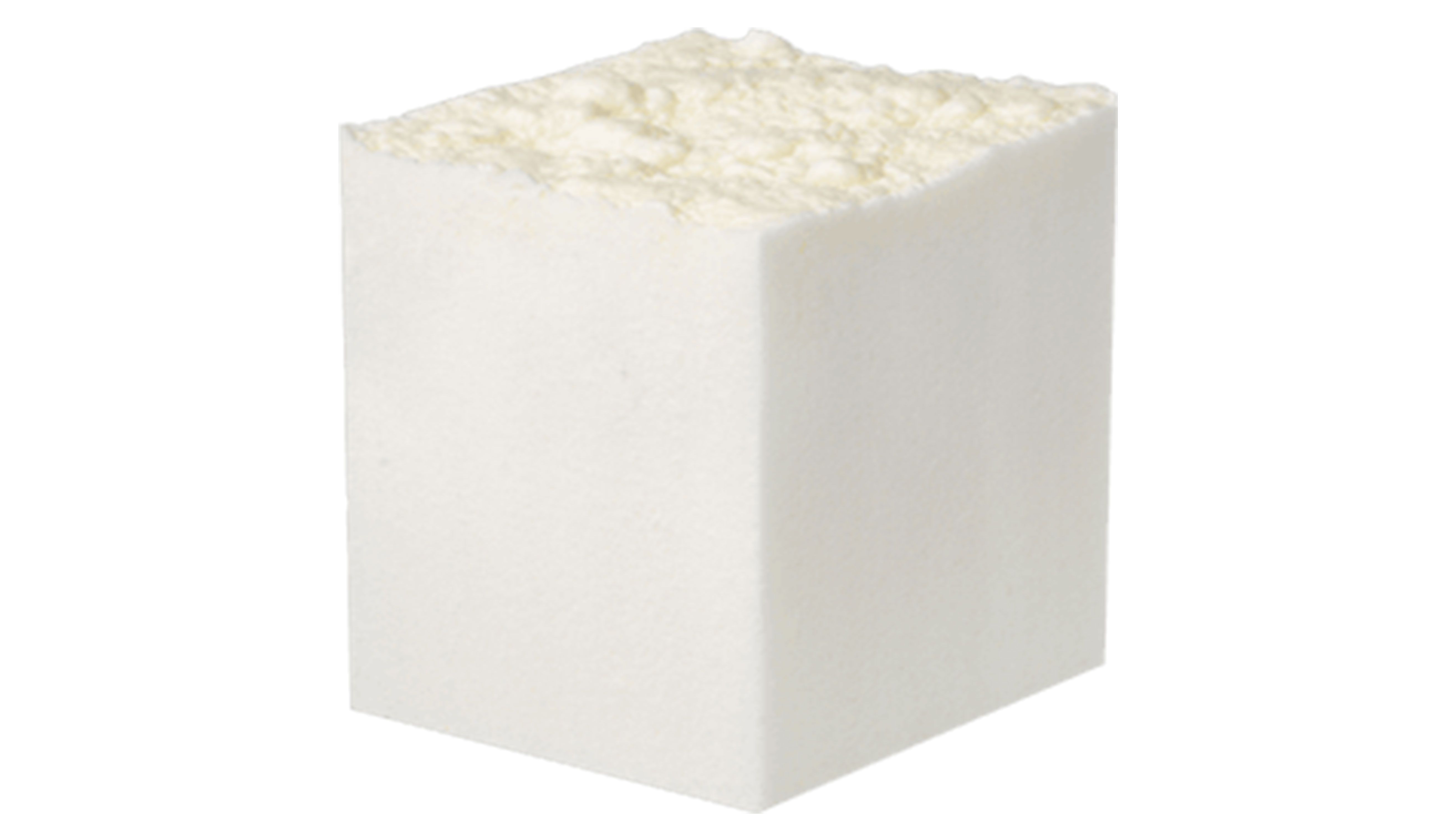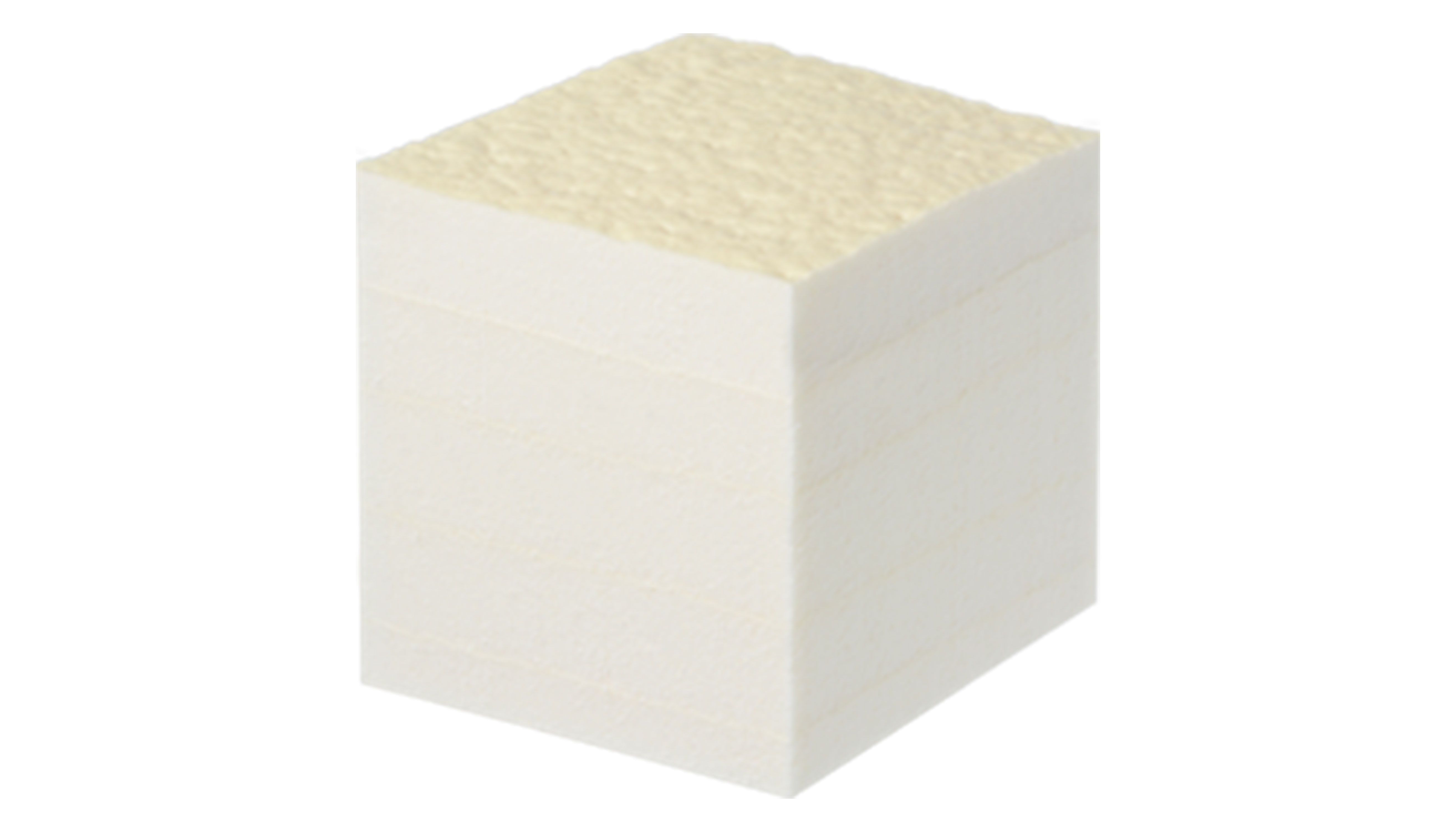Polyurethane foams and their properties
Polyurethane is substantially made of two raw materials — isocyanate and polyol, which are derived from crude oil. After mixing those two process-ready liquid components of the system and various auxiliary materials, such as catalysts, foaming agents, and stabilizers, a chemical reaction starts.
The history of polyurethane dates back several generations. At first, there was a technology of producing rigid (hard) foam, then flexible foam, and finally semi-rigid foam.
What properties does PUR foam have? Above all, it demonstrates good thermal parameters — it is resistant to a wide range of temperatures (from –200°C to +135°C). Average thermal conductivity coefficient of polyurethane foam is 0.026 W/m2, and the most favourable apparent density after the curing of rigid foam is usually 35 – 50 kg/m³.
The greatest advantage of PUR foam is its excellent thermal insulation properties. Polyurethane foam is also resistant to relatively high loads, as well as fungi and mould. Thus, it is undoubtedly an ideal material for any construction and renovation works, such as thermal and acoustic insulation, and — in the case of flexible polyurethane foam — fitting and sealing.
PUR foam provides perfect adhesion to both vertical and horizontal surfaces, and it has porous structure. Porous materials have hollow cavities inside. Porosity is a property that tells us about the volume and quantity of pores with certain diameter. Polyurethane foam is also characterized by a short treatment time and, after curing, it retains its chemical neutrality.
When it comes to disadvantages of the material, its relative flammability and low resistance to UV radiation are often mentioned.
Open- and closed-cell foams
 Polyurethane foam is divided into two basic types — open-cell and closed-cell. The former is intended for indoor use, particularly for insulating walls and roofs as well as increasing acoustic comfort of a room, as polyurethane foam — besides thermal insulation properties — has a very high noise reduction coefficient. Open-cell foam is vapour-permeable, so that we can say that a surface covered with it “breathes.” Sprayed from the inside, directly on the roof, it can be easily used on a membrane or boarding.
Polyurethane foam is divided into two basic types — open-cell and closed-cell. The former is intended for indoor use, particularly for insulating walls and roofs as well as increasing acoustic comfort of a room, as polyurethane foam — besides thermal insulation properties — has a very high noise reduction coefficient. Open-cell foam is vapour-permeable, so that we can say that a surface covered with it “breathes.” Sprayed from the inside, directly on the roof, it can be easily used on a membrane or boarding.
When it comes to technical parameters — open-cell foam has density of 7–14 kg/m3, while its thermal conductivity coefficient ranges from 0.034 to 0.039 W/(m*K). Among the types of open-cell polyurethane foam, there are materials with different fire rating. The best ones are rated E.
 Another group — closed-cell polyurethane foam — due to its high water resistance, higher rigidity, and strength, is used outdoors and in rooms with high humidity.
Another group — closed-cell polyurethane foam — due to its high water resistance, higher rigidity, and strength, is used outdoors and in rooms with high humidity.
Its structure contains more than 90% of closed cells and its density ranges from 30 to 60 kg/m3. Thermal conductivity coefficient of closed-cell polyurethane foam ranges from 0,02 to 0,024 W/(m*K).
Closed-cell foam types differ in parameters depending on their application. On the one hand, it is perfect for insulating foundation walls, ceiling structures, roofs, and floors. On the other hand, it can be used in industrial and agricultural buildings, for example to insulate production floors, warehouses, cold stores, or livestock buildings.
Single- and two-component foams
The two types differ in that the former needs humidity from air and from construction materials to cure. The latter undergoes curing as a result of a chemical reaction between its two components.
Single-component foam is used in rooms with unrestricted air flow and outdoors. The reason is simple. The higher humidity (over 35%) and air temperature, the quicker curing of the foam. Within ca. 25 minutes, foam grows in volume by around 35%, therefore cavities must be filled in just about 50% or 60%.
Two-component fitting foam undergoes chemical curing without access to moisture. Therefore, it can be used in difficult-to-access areas that are dry and require foam of excellent quality. This type of foam is also suitable for joining woodwork in a fixed manner. Within ca. 25 minutes, two-component foam grows in volume by around 30%, therefore you should remember not to fill cavities completely, but only in 80%.
Gun-spray and hose-spray foams
Gun-spray and standard (hose-spray) rigid polyurethane foams are commonly used sealing materials. Application method is crucial here. The former type requires a special foam gun, which allows precise application. Hose-spray foam, on the other hand, owe its name to a special hose through which foam is sprayed. This type of foam is used more frequently, because it is cheap and it does not require any special tools for applications.
Winter, summer, and whole-year foams
Polyurethane foams may be distinguished according to outdoor temperature range during treatment. As the name itself indicates, winter foams are used in low temperature, while summer foams when the temperature is at least 10°C. Whole-year foam features the best temperature tolerance. Remember, however, that the latter is to be avoided in both extremely low and extremely high temperatures.

 This website uses cookies. By using this website, you consent to the use of cookies in accordance with your browser settings.
This website uses cookies. By using this website, you consent to the use of cookies in accordance with your browser settings.